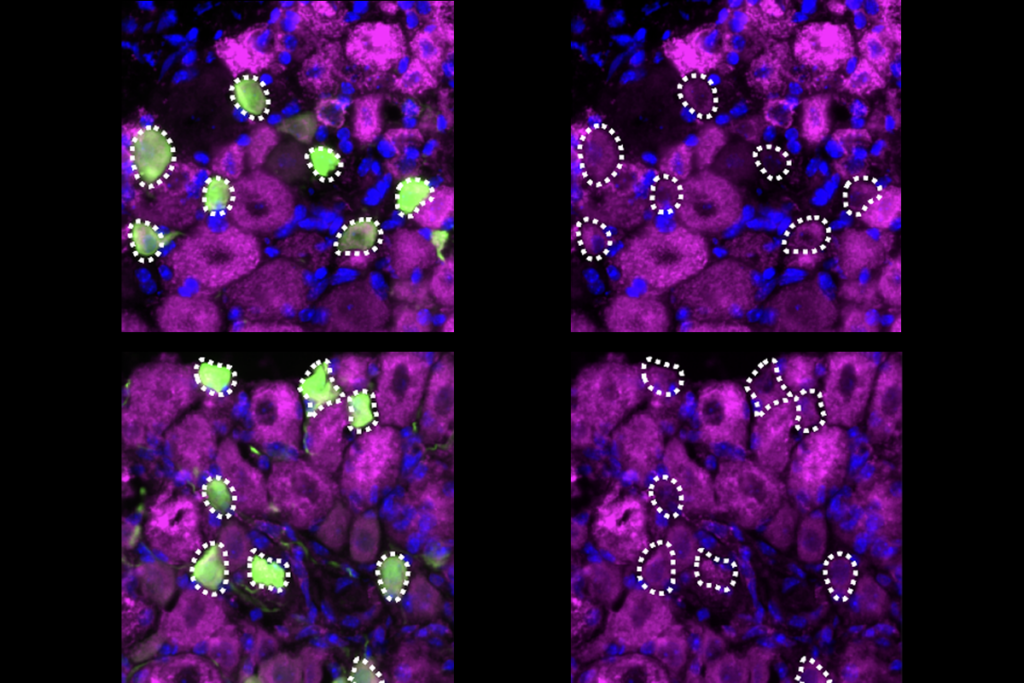Unlike the primary sensory brain areas that process sights and sounds, the one that decodes scents also responds to other stimuli, such as images and words associated with an odor, according to a study published today in Nature.
The extent to which neurons in the primary olfactory cortex, which includes the piriform cortex, respond to non-odor stimuli was surprising, says Marc Spehr, head of the Chemosensation Laboratory at RWTH Aachen University, who co-led the study. One neuron, for example, which activated in response to the scent of black licorice, also responded to the word “licorice,” images of the candy and the odor of anise seed, which is unrelated but has a similar scent. Cells in the amygdala also showed multimodal responses; one neuron, for example, responded to a banana scent as well as the word “banana.”
“These aren’t odor signals that these cells are encoding; these cells are encoding concepts,” says Kevin Franks, associate professor of neurobiology at Duke University, who was not involved in the work but wrote a News and Views article on it. “So in this part of the brain, traditionally being considered this primary sensory area, you have sensory invariant conceptual representations of specific types of objects. And that’s really, really cool.”
Smell-detecting neurons in the nose project into the brain’s olfactory bulb, which then passes information directly to the piriform cortex and other parts of the primary olfactory cortex. That means the piriform cortex lies only two synapses away from the stimuli it decodes, Franks says. In the visual system, on the other hand, a cell two synapses away from a photon is still in the retina, he says.
Despite the limited odor processing that happens before the signal reaches the piriform cortex, there have been earlier hints that the area acts more like an association cortex than like other primary sensory areas, says Thorsten Kahnt, investigator at the U.S. National Institute on Drug Abuse, who was not involved in the work. For example, piriform neurons respond to both particular smells and particular locations, according to a 2022 study of rats trained to associate certain scents with specific locations in a maze. And in people, the area as a whole lights up in response to odors as well as emotional facial expressions, a 2017 functional MRI study found. “But in humans, we never had single cell resolution,” Kahnt says.
The new study, which involved single-neuron recordings from 17 people undergoing presurgical seizure monitoring via implanted electrodes, reveals how information about an odor is transformed throughout the olfactory cortex. Odor-responsive neurons in the amygdala and hippocampus also seem to be involved in different aspects of odor processing, the team reported.
All that, Franks says, reinforces the understanding that the olfactory cortex “is, at the same time, incredibly complex and sophisticated, while also being ancient and quite simple.”
T
he participants underwent observation to pinpoint the source of their seizures ahead of their surgeries, during which time doctors inserted multiple hollow electrodes into their medial temporal cortex. Spehr and his colleagues were able to insert wire electrodes inside those clinical electrodes, enabling the team to record from the piriform cortex, amygdala, entorhinal cortex and hippocampus.During the recordings, the awake participants sniffed 15 different odors—including garlic, banana, fish and turpentine—emitted by Sniffin’ Sticks odor pens. Single neurons in the piriform cortex and amygdala responded first, within 500 milliseconds, followed by neurons in hippocampus and entorhinal cortex, the team found.
The researchers could accurately predict the identity of an odor based on activity from each of the four areas, with the piriform cortex producing the most reliable results. And some of those same odor-responsive neurons activated when the participants looked at images of the stimuli or read the written name of the odor. Further experiments suggested that the piriform cortex was more accurate at decoding images than any other area they tested.
Neurons in the amygdala encode additional information about the valence of an odor, the team also found by asking participants to identify each scent and rate it as pleasant or unpleasant. Odor-sensitive cells in the amygdala fired more rapidly for pleasant smells than for unpleasant ones. The activity of hippocampal neurons, on the other hand, could predict a person’s ability to identify an odor, suggesting that these cells respond to a person’s perception of what they smelled.
The new study hints at how odor information travels through the brain: Neurons in the piriform cortex—but not other areas—show a decreased response from the first to the second time an odor is presented, the team found. “It’s an indication that the piriform is not a relay station of that information,” and that the odor information may be processed in parallel by the piriform cortex and other areas, such as the entorhinal cortex, Spehr says.
T
he way this information is transformed along the human olfactory pathway “largely fits with the view of the system that comes from animal studies,” says Elizabeth Hong, professor of neuroscience at the California Institute of Technology, who was not involved in the study. “This [system] basically does these transformations of stimuli into semantic inferences or meaning, essentially, in a very small number of steps,” she says.One difference, however, is that rodents’ olfactory bulbs project directly to the entorhinal cortex, whereas in humans, the entorhinal cortex became active only after the piriform cortex and amygdala, Spehr and his colleagues note in the paper.
Future work is needed to better understand some of the findings, such as how the amygdala encodes valence information about odors, Hong says. It is not clear why neurons would increase their firing rate in response to pleasant but not unpleasant stimuli, she says. “I would think that if you really dislike something, that you might also get a very salient signal.”
It could also be informative to tease out how cells respond to a person’s perception of an odor versus its chemical code, Kahnt says. “The hippocampus represents what the person thinks the odor is, rather than what is actually is.” But what exactly drives a response in the piriform cortex is difficult to identify with the number of scents the team was able to test, given the limitations of recording from awake participants undergoing monitoring, he says.
Moving forward, the team aims to conduct similar experiments using an olfactometer, which can administer odor stimuli more precisely than an odor pen can, Spehr says. That could help pin down the exact timing of odor processing, he says.
Spehr also says he hopes to study whether neurons in the piriform cortex respond to images that are not directly linked to odors. For example, if a person viewing a picture of the Eiffel Tower has previously visited the landmark, perhaps their neurons would show associations with a smell they experienced during that visit, he says. But it would be interesting to see if any such response exists for people who have never been there.
“What the exact role of this brain area in multi-sensory integration is—that will be something we will certainly pursue,” Spehr says.





